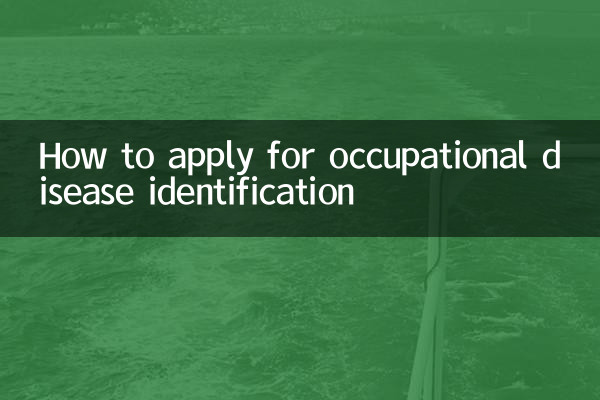How to apply for occupational disease identification
Occupational disease identification is an important way for workers to confirm their occupational relevance through legal procedures for diseases caused by the working environment or the nature of their occupation. In recent years, as attention to occupational health has increased, the process and precautions for applying for occupational disease identification have become a hot topic. The following is a summary of popular discussions on the Internet in the past 10 days, analyzed in detail for you based on structured data.
1. Application conditions for occupational disease identification

| condition type | Specific requirements |
|---|---|
| Occupational exposure history | Proof of working in a relevant type of work for more than 1 consecutive year is required |
| disease type | Must belong to the 132 diseases in the "Classification and Catalog of Occupational Diseases" |
| time requirement | Apply within 2 years of onset of symptoms |
2. Application process (five-step method)
| step | Operation content | Materials required |
|---|---|---|
| first step | Go to the occupational disease diagnosis institution where the employer is located to collect the application form | ID card, labor contract |
| Step 2 | Submit occupational history and medical statement | Physical examination reports and job descriptions over the years |
| Step 3 | Take a medical exam | Diagnostic facility checklist |
| Step 4 | Waiting for diagnosis conclusion (within 30 working days) | Acceptance receipt |
| Step 5 | If you have objections to the results, you can apply for provincial appraisal. | Original diagnosis certificate and appeal letter |
3. Latest policy changes (updated in 2024)
According to the recently revised version of the "Management Measures for Occupational Disease Diagnosis and Identification" issued by the Ministry of Human Resources and Social Security, the main changes include:
| Changes | old rules | new regulations |
|---|---|---|
| Application time limit | Within 1 year after termination of labor relationship | Extended to within 2 years |
| burden of proof | Workers need to provide some evidence themselves | The employer bears the primary burden of proof |
| Appraisal fee | Personal responsibility 20% | All paid by the work injury insurance fund |
4. Frequently Asked Questions
According to the big data analysis of online consultation in the past 10 days, the three major issues that workers are most concerned about are:
| question | frequency of occurrence | solution |
|---|---|---|
| The employer is uncooperative | 43.7% | You can complain to the local health commission and apply for administrative intervention |
| Incomplete materials | 32.1% | Substitute evidence such as testimonials from colleagues and salary slips |
| Inter-provincial identification | 18.5% | You can apply at your current place of residence, and the location of your original employer is required to assist you in checking. |
5. Notes on rights protection
1.Evidence preservation: Daily preservation of original evidence such as attendance records, photos of working environment, etc.
2.Timeliness control: Pay attention to the different time limit requirements for diagnosis applications and labor arbitration
3.Professional assistance: It is recommended to obtain professional guidance through trade unions or legal aid agencies
A recent hot search case shows that an employee of an electronics factory successfully supplemented the history of exposure to harmful substances through WeChat work group chat records. This innovative method of proof was adopted by the appraisal committee. This reminds workers that they should pay attention to retaining all types of electronic evidence.
Occupational disease identification involves knowledge in many fields such as medicine and law. It is recommended to conduct professional consultation through the official website of the "National Occupational Health Platform" or the 12333 hotline before applying. The latest statistics show that in the first half of 2024, the national occupational disease diagnosis pass rate reached 68%, an increase of 12% from previous years, indicating that with the optimization of processes, the protection of workers' rights and interests is continuing to be strengthened.

check the details

check the details